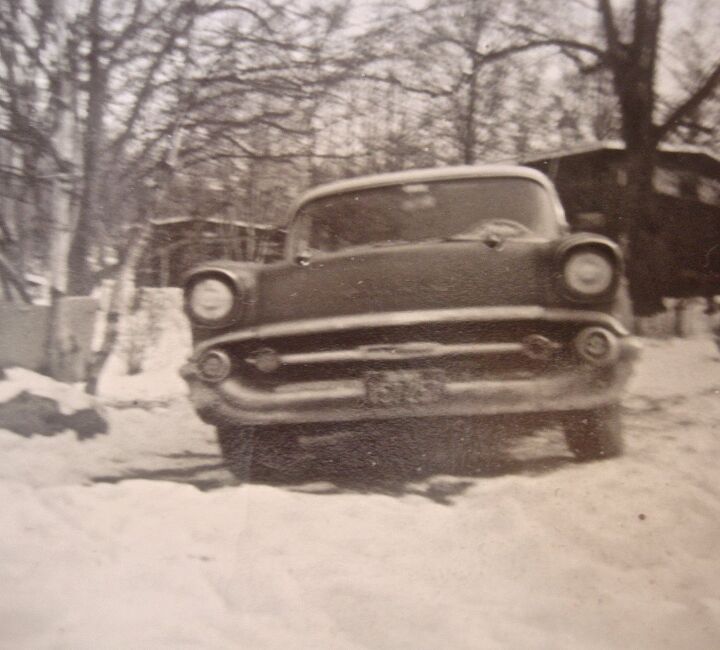Grace Braeger Has Been Driving The Same Car For Fifty-Six Years. We Asked Her Why.

It was like finding a living mammoth, or one of those miniature elephants that still inhabited some islands off the coast until about four thousand years ago. There, in the video, was Grace Braeger pulling up to the gas pumps in her 1957 Chevy, which she had bought new, back in the fall of 1957, about the same time my parents and my brother and I had gone to the car store to get our ’57 Chevy wagon, when I was 4. We had bid ours adieu 8 years later. But the memories surged as I watched Ms. Braeger pump gas. The chrome gas cap cover doubles as the back of the tailfin, and there it was, flicked back to accommodate the nozzle. Then the scene shifts, and I’m riding shotgun, watching Ms. Braeger hang a right and then a left, steering hand over hand—with gusto and panache!—a necessary technique in the days of five turns lock to lock.
Our ’57 Chevy (pictured above) went geriatric around 75,000 miles, and by the time it reached the 90s, blue smoke would stink up the passenger compartment every time we climbed Belmont Hill, the car struggling in second gear. I sometimes dream that the 57 Chevy mysteriously reappears in front of my house after all these years, only to become irrevocably lost again, a dream that beautifully expresses the nature of the human condition. And yet, here’s a sibling ‘57 Chevy that’s 56 years old and looks like it just came off the showroom floor! How and why did Ms. Braeger keep hers going?
Ms. Braeger hadn’t planned to keep the car, her second, forever, but it just sort of worked out that way, she says. The years went by, and in 1975, when the car was 18 years old, it was still clean and reliable, due to low mileage and meticulous care. So she joined the local 1955-56-57 Chevy club, but for purely practical reasons. She figured club members would know where to find parts (that never became a problem).
Then, as the car aged into classic car status, Ms. Braeger discovered the joys of owning an icon. “People wave and smile and honk, and always notice the car,” she says. In fact, when asked about the pleasure of driving, she refers neither to the sound and feel of the 4 barrel, 283 cubic inch V8 (~4.6 liters), nor to the presumably deep satisfaction of a long-term relationship between human and machine, but once again to the people smiling and giving her the thumbs up. She says “It’s like having my own car show on the street!”
Asked (again!) about whether she enjoys, say, the feel of the engine, she responds, “To tell you the truth, I don’t do that much accelerating. And I coast to stop signs. I’m sure some people behind me are somewhat aggravated.” (I doubt it. Last year the federal Food and Drug Administration approved classic cars as an antidote to road rage.)
But in 1987, what with so many holes in the floorboards that Ms. Braeger feared a heavier person might have fallen through, she had the body restored. “The doors were taken off, the insides were removed, so the floorboards could be replaced, and the dash was taken apart so it could be repainted, and so forth,” she says. But the drivetrain went untouched.
One thing that undoubtedly helped preserve the engine was oil changes every thousand miles. (In those days, a lube and oil change was standard every 2,000 miles.) In its nearly one hundred and nineteen thousand miles—slightly more than 2,000 miles a year–the engine has never had a major repair, and Don Meyer, a manager at Heiser Chevrolet in West Bend, says it sounds and feels really good. (From the video, the engine sounded really good to me, too.) Nonetheless, it has a bit of blowby, says Dave Priddy, who works on the car at nearby Heiser Toyota, and who has owned three’57 Chevys. He says he can tell by looking at the spark plugs, and from the smoke that comes out of the vent tube in the back of the block. But other than tires and the exhaust system, the car “is pretty much original,” he says.
“It’s surprising how nice it goes on the road,” says Priddy. “You can get onto the freeway at 55-60 [mph], no problem. I love driving it. It’s a pretty smooth ride, and not at all rattley. It glides.” But Ms. Braeger admits somewhat ruefully that it gets only 10 mpg.
One of the perks of keeping your car for… well, a lifetime, is a lifetime’s supply of Midas mufflers. Braeger got her first in ’62. Several years ago, though, when she needed a new one, the local Midas dragged its feet, telling her for weeks that it was “on order.” Braeger finally “took it into my own hands, and contacted someone higher up in Midas,” and she got her muffler. But the next time she needed a new muffler, the guy wouldn’t deal with her at all. So she contacted the next closest Midas, where they were happy to help, only to find that Midas had quit making mufflers for ’57 Chevys. Not to worry! Midas International had one made specially, and flew it in from New Jersey. Fox News attended the installation. And, Ms. Braeger notes, “I have two mufflers, because it’s dual exhaust.”
All those years, and all those mufflers—23, in total–and so few road trips. Aside from driving the 400 miles from West Bend to St. Louis when she moved there in ’67, and the return trip in ’01, when she moved home again, and perhaps a few trips between the two in the late ‘60s—she isn’t sure—Ms. Braeger has taken but two major road trips in the Chevy. In 1958, and again in 1960, she drove from West Bend to Edmonton, Alberta, and back, then a 4,000 mile round trip.
And who is this lady who may hold the record for the longest single person ownership of a ’57 Chevy, at least outside of Cuba? She’s a live wire, who hopes to get her car into the Guinness book of World Records, and who asked me if I thought my article would go viral (oh, please, oh, please!). And although she’s a Lutheran Deaconess, she’s obviously not one of those shy Norwegians who populate Lake Wobegon, Minnesota. She’s an accomplished professional, a rarity among women of her generation, who began her second career conducting charitable fundraisers, and moved to St. Louis to work for the Missouri Synod’s Lutheran Layman’s League, on The Lutheran Hour, a worldwide program which was produced in the languages of the different countries where it aired. Later, she worked for the Missouri Synod’s attorney.
I learned about Ms. Braeger and her car from a generally uninformative article in a major newspaper. It said the ’57 was the only car she’d driven since she bought it. She hasn’t driven a single other car since 1957???! “No.” It seemed unlikely, so I asked her again. It’s true.
She also says she thinks she might want to get one more new car in her life. I’m thinking, what with the slit windows you can barely see out of, the low seating, and all the funky digital controls on the instrument panel, and the colorless gray styling on modern cars, she’s better off keeping the ‘57.

I'm a freelance journalist covering science, medicine, and automobiles.
More by David C. Holzman
Latest Car Reviews
Read moreLatest Product Reviews
Read moreRecent Comments
- 1995 SC Didn't Chrysler actually offer something with a rearward facing seat and a desk with a typewriter back in the 60s?
- The Oracle Happy Trails Tadge
- Kwik_Shift_Pro4X Union fees and corruption. What can go wrong?
- Lou_BC How about one of those 2 foot wide horizontal speedometers out of the late 60's Ford Galaxie?
- Lou_BC Was he at GM for 47 years or an engineer for 47 years?


































Comments
Join the conversation
"...but I would not rate it “one of the greatest cars ever made in the U.S.” It was a remarkably successful and brilliant restyle of the 55-56 body (but Ford outsold it that year)." Ford outsold Chevy that year because Ford was all-new and lower, longer, wider...but they rusted to bits in just a few years. Plymouth was a TOTAL POS in '57, thanks to rushing their lower-longer-wider "Suddenly it's 1960" models into production. Read it for yourself, from someone who was there. http://www.allpar.com/history/inside/plymouth-5.html So in addition to the fact that the '55 Chevies were already a perfect storm of styling, engineering and build quality in the "low-price field", selling in record numbers...the comparison between the '57 Chevy and its peers in the years since they were new virtually guaranteed them icon status. Comparable Fords and especially Plymouths weren't as durable. And I haven't even touched on the blossoming youth market and the qualities of the Small-Block Chevy engine, ensuring the Tri-Fives' legacy as a hot rod. David, your car turned to smoke as soon as it did because it had the Blue-Flame 235 6-cylinder. (The lack of a "V" on the hood and the placement of the "Chevrolet" badge is the giveaway) ALL 235s smoked after some time. I owned 6 of them in different vintage Chevies and they all used oil. A well-cared-for 265/283 would've done better. The 235 was one of the only pieces carried over from the '54 models. BTW I never got any better than 16 MPG on any of my 235's. No-Flame 6 aside, the cars were simply brilliantly engineered for their time and target customer...unless you had a '57 Turboglide...this part of the story amazes me many Turboglides broke down and were tossed for Powerglides. Switching either automatic for a stick would probably yield a 3-4 MPG improvement...remember there were no locking torque converters or electronic controls in 1957. But tranny aside, Ms. Braeger started out with a great car. True, IN ITS DAY, as a new car, the '58 was favored over the '57...but build quality was an issue, and between the new X-Frame and all-coil suspension, engineered for pillow-smooth ride over handling...before anyone was using sway bars, at least on American family cars...the '58 ended up a disaster. The '55-'57 front suspension - perfect for a Tri-Five - was carried over and now had to carry extra weight and mass. So I respectfully disagree with anyone who would downplay the importance or popularity of the '55-'56-'57 Chevrolet. More on Curbside Classic: http://www.curbsideclassic.com/curbside-classics-american/curbside-classic-1955-chevrolet-the-icar/ http://www.curbsideclassic.com/blog/weekend-salon-so-what-exactly-was-gms-all-time-greatest-hit/ sgeffe, Tri-Fives came in 18-19 models...more were sedans than not but the 2-door hardtops in particular were very popular. The 4-door HT was new for '56.
David, My parents bought a new 57 Chrysler Windsor in Oct 1956. We moved from Dayton, OH to Houston, TX in Aug 1958. My father traded it for a new 59 Plymouth Sports Suburban wagon with factory air in the Fall of 1958. The body styling was more advanced but the body and the hardware were not so good. The two years my parents had the Chrysler the dark metallic blue paint had faded badly but the white tutone part did not fade. The Plymouth was all white and we had it for 2 years until my brother was hit and it twisted the frame railings so bad that it could not be repaired. If it would had been a Chevy or a Ford it could have been repaired because they had full frames. My father in retrospect wishes he would have bought a 57 Chevy but my mother liked the looks of the 57 Chrysler and wanted the push button drive. The 57 Chevy stood the test of time where the Fords and Chrysler products were not built to last. To this day I am not that big of a Chrysler fan.